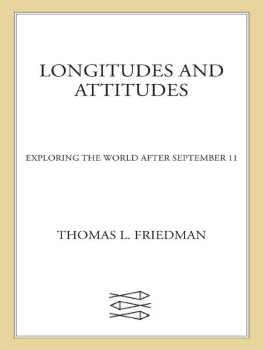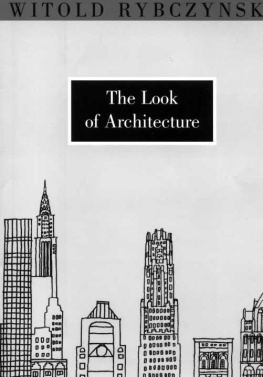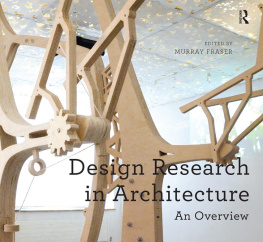ROGER FULLINGTON SERIES IN ARCHITECTURE
The American Idea of Home
Conversations about Architecture and Design
BERNARD FRIEDMAN
FOREWORD BY MEGHAN DAUM

UNIVERSITY OF TEXAS PRESS
AUSTIN
Publication of this book was made possible in part by support from Roger Fullington and a challenge grant from the National Endowment for the Humanities.
Copyright 2017 by Bernard Friedman
Foreword copyright 2017 by Meghan Daum
All rights reserved
First edition, 2017
Requests for permission to reproduce material from this work should be sent to:
Permissions
University of Texas Press
P.O. Box 7819
Austin, TX 78713-7819
http://utpress.utexas.edu/index.php/rp-form
Design by Lindsay Starr
Library of Congress Cataloging-in-Publication Data
Names: Friedman, Bernard, author. | Daum, Meghan, 1970 writer of supplementary textual content.
Title: The American idea of home : conversations about architecture and design / Bernard Friedman; foreword by Meghan Daum.
Description: First edition. | Austin : University of Texas Press, 2017. | Includes index.
Identifiers: LCCN 2016037108
ISBN 978-1-4773-1286-5 (cloth : alk. paper)
ISBN 978-1-4773-1287-2 (pbk. : alk. paper)
ISBN 978-1-4773-1288-9 (library e-book)
ISBN 978-1-4773-1289-6 (non-library e-book)
Subjects: LCSH: ArchitectureUnited States. | ArchitectsInterviews. | Architectural design.
Classification: LCC NA705 .F75 2017 | DDC 720.973dc23
LC record available at https://lccn.loc.gov/2016037108
doi:10.7560/312865
To my parents, Judy and Abel Friedman,
who understood so well how a home worked.
CONTENTS
MEGHAN DAUM
BERNARD FRIEDMAN
FOREWORD
No Place Like It
MEGHAN DAUM
In the canon of common dreams, its a classic among classics: the dream in which we discover an unfamiliar room in a familiar house. The way it usually goes is that were in some kind of living space, maybe our own, maybe a space thats inexplicably taken some other form (It was my grandmothers house, but somehow the prime minister of France lived there!), and suddenly theres more of it. Suddenly the place has grown a new appendage. But its not exactly new. Theres a sense that its been there all along yet has managed to escape our notice. Sometimes theres just one new room, sometimes there are several. Sometimes theres an entire wing, a greenhouse, a vast expanse of land where wed once only known a small backyard.
We are amazed, enchanted, even chastened by our failure to have seen this space before now. We are also, according to psychologists and dream experts, working through the prospect of change, the burgeoning of new possibilities. The standard interpretation of the extra-room dream is that its a portent, or just a friendly reminder, of shifting tides. The room represents parts of ourselves that have lain dormant but will soon emerge, hopefully in a good way, but then again, who knows? Look harder, says the extra-room dream, the geometry of your life is not what it seems. There are more sides than you thought. The angles are wider, the dimensions far greater than youd given them credit for.
Not that we can hear much on that frequency. The human mind can be tragically literal. Chances are we exit the dream thinking only that our property value has increased. But upon fully waking up, the extra room is gone. Theres a brief moment of disappointment, then we enter our day and return to our life. We organize our movements in relation to the architecture that is physically before us. That is to say, we live our lives in the spaces weve chosen to call home.

Lets get one thing straight. A house is not the same as a home. Home is an idea, a social construct, a story we tell ourselves about who we are and who and what we want closest in our midst. There is no place like home because home is not actually a place. A house on the other hand (or an apartment, a trailer, a cabin, a castle, a loft, a yurt) is a physical entity. It may be the flesh and bones of a home, but it cant capture the soul of that home. The soul is made of cooking smells and scuffmarks on the stairs and pencil lines on a wall recording the heights of growing children. The soul evolves over time. The old saying might go, You buy a house but you make a home, but, really, you grow a home. You let it unfold on its own terms. You wait for it. Home is rarely in the mix the day we move into a new house. Sometimes its not even there the day we move out. Its possible we should consider ourselves lucky if we get one real home in a lifetime, the same way were supposedly lucky if we get one great love.
All architecture is shelter, said the postmodernist Philip Johnson. All great architecture is the design of space that contains, cuddles, exalts, or stimulates the persons in that space.
If all architecture, no matter its purpose, is shelter, then architecture intended as shelter must be the ultimate haven. If an airport or a library can cuddle, exalt, and stimulate, a houses embrace must be at once profoundly intimate and ecstatically transportive, erotic even.
I guess this is where I come clean. I write this as a person for whom houses can have an almost aphrodisiacal quality. I say almost because the other charge I get from a beautiful house feels like something close to the divine. A perfect houseand by that I mean a respected house, one that was honorably designed and solidly built and allowed to keep its integrity henceforthis a tiny cathedral. But a perfect house is also lust made manifest. It can make its visitors delirious with longing. It can send butterflies into their bellies in ways a living, breathing human being rarely can. A house thats an object of lust says, You want me, but youll never have me. It says, You couldnt have me even if you could afford me. You couldnt have me even if I didnt already belong to someone else. And that is because houses, like most objects of lust, lose their perfection the moment were granted access. To take possession of a house is to skim the top off of its magic the minute you sign the deed. It is to concede that the house you live in will never be the house you desired so ravenously. It is to accept that the American dream of homeownership is contingent upon letting go of other dreamsfor instance, the kind where the rooms appear where there were none before.
Maybe thats why architects are such sources of fascination, even aspiration. If they want an extra room, they just draw it. If they want a bigger window, a wider archway, a whole new everything, the pencil will make it so. At least thats the laypersons fantasy. Its not surprising that so many fictional heroes in literature and film are architects. The profession, especially when practiced by men, seems to lend itself to a particularly satisfying montage of dreamboat moments. Here he is, artistic and sensitive at his drafting table. Here he is, perched on the steel framework of a construction site high above the earth, hard hat on his head, building plans tucked under his arm in a scroll. Here he is, gazing skyward at his final creation, his face lit by the suns refraction off his glass and steel, awestruck by the majesty of it all and awesome in his own right.
Nearly always, these are men on a mission. Theirs is not a vocation but a passion that both guides them and threatens to ruin them. In Ayn Rands novel The Fountainhead (perhaps the ne plus ultra of architect fetishization), the grindingly uncompromising Howard Roark winds up laboring at a quarry because he wont betray his aesthetic principles. In Graham Greenes
Next page













